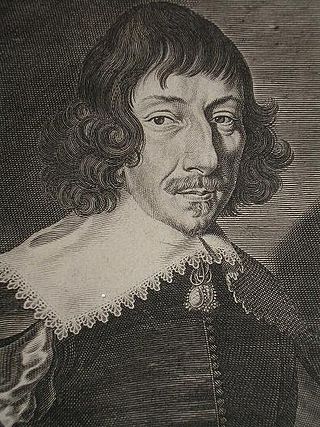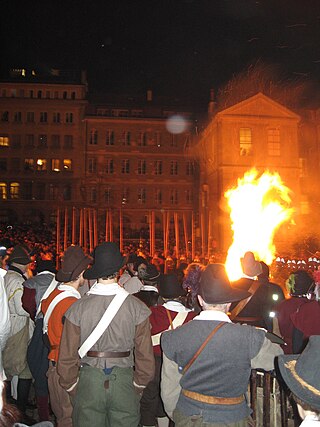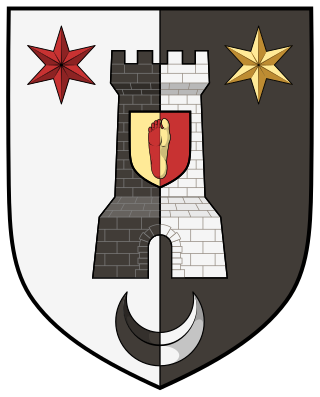
Jean Antoine Letronne was a French archaeologist.

Marie de Gournay was a French writer, who wrote a novel and a number of other literary compositions, including The Equality of Men and Women and The Ladies' Grievance. She insisted that women should be educated. Gournay was also an editor and commentator of Michel de Montaigne. After Montaigne's death, Gournay edited and published his Essays.

Charles Sorel, sieur de Souvigny was a French novelist and general writer.

David-Augustin de Brueys was a French theologian and playwright. He was born in Aix-en-Provence. His family was Calvinist, and he studied theology. After writing a critique of Jacques-Bénigne Bossuet's work, he was in turn converted to Catholicism by Bossuet in 1681, and later became a priest.
The Treaty of Huế, concluded on 25 August 1883 between France and Vietnam, recognised a French protectorate over Annam and Tonkin. Dictated to the Vietnamese by the French administrator François-Jules Harmand in the wake of the French military seizure of the Thuận An forts, the treaty is often known as the 'Harmand Treaty'. Considered overly harsh in French diplomatic circles, the treaty was never ratified in France, and was replaced on 6 June 1884 with the slightly milder 'Patenôtre Treaty' or 'Treaty of Protectorate', which formed the basis for French rule in Vietnam for the next seven decades.

The Treaty of Huế or Protectorate Treaty was concluded on 6 June 1884 between France and Đại Nam. It restated the main tenets of the punitive Harmand Treaty of 25 August 1883, but softened some of the harsher provisions of this treaty. The treaty, which formed the basis for the protectorates of Annam and Tonkin, and for French colonial rule in Vietnam during the next seven decades, was negotiated by Jules Patenôtre, France's minister to China, and is often known as the Patenôtre Treaty. The treaty was signed on the Vietnamese side by Phạm Thận Duật and Tôn Thất Phan, representatives of the emperor Tự Đức’s court. The treaty marked the Nguyễn dynasty's second acceptance of French protectorate in central and northern Vietnam, but it was canceled by the Nguyễn dynasty on 11 March 1945.

Marc Vulson de la Colombière (†1658) or Sieur de la Colombière was a French heraldist, historian, poet, minion of the royal court. His name is sometimes spelt as Wulson and also as Volson.
Régine Pernoud was a French historian and archivist.

Jean Sirmond was a neo-Latin poet and French man of letters, historiographer of Louis XIII.

The Académie Royale de Danse, founded by Letters Patent on the initiative of King Louis XIV of France in March 1661, was the first dance institution established in the Western world. As one of King Louis’ first official edicts after the death of royal adviser Jules Mazarin, the “Letters Patent of the King to Establish a Royal Academy of Dance in the City of Paris” represented a critical step towards the young King's wielding of consolidated personal power. Structurally, the Académie consisted of thirteen dancing masters selected by King Louis XIV for being the “most experienced in the Art [of dance].” This "experience" was determined by each dancer's history of success in previous royal productions of ballets de cour. Most famously, eight of the selected dancing masters performed with King Louis XIV during his portrayal of Apollo, the Sun King, in LeBallet de la nuit (1653). Although the object of the Académie was to reflect, analyze and normalize matters of dance, no document relating to its activity or to this theorization has survived. The Académie Royale de Musique, founded in 1669 as the Académie d'Opéra, was a closely related opera and ballet company, and although the two institutions never merged, members of the dance academy were also associated with the opera. Little by little, recruitment of dancers into the royal entourage gave way to recruitment into the ballet-corps of the Opéra. This slowly altered the Académie's profile, making it and its members more dedicated to dance training alone. By 1775, the Académie was nearing the end of its life. On joining the Académie, Jean-Georges Noverre, one of ballet d’action’s most influential choreographers, commented on its ineffectiveness in making meaningful contributions to the dance world. But Noverre’s dismissive remarks concerning the organization cannot be taken at face value, since on a number of accounts, his statements are polemical, biased and misleading. It is often claimed that the Académie ceased to exist after 1778, merely because a list of the thirteen members was no longer published after this date, or alternatively after 1789, with the coming of French Revolution and the abolition or nationalization of royal institutions. In a tribute to his deceased brother Maximilien published in the Courrier des spectacles , Pierre Gardel, the head choreographer at the Paris Opéra at that time, writes that “these positions, which came with a pension [of 500 livres], passed in turn to the most distinguished dancers. Citizens [Auguste] Vestris and [Pierre] Gardel, currently at the Théâtre de la République et des Arts, are the last to have enjoyed these.” It appears then that the Académie was indeed defunct by 1798. The opera and ballet company has survived and today is known as the Opéra National de Paris.

Barthélemy Mercier de Saint-Léger was a French abbot and librarian.

The Compagnie de 1602 is an historic and patriotic association in Geneva who organize the official commemoration of the Escalade. This association was established on March 31, 1926.

The Cassini Map or Academy's Map is the first topographic and geometric map made of the Kingdom of France as a whole. It was compiled by the Cassini family, mainly César-François Cassini and his son Jean-Dominique Cassini in the 1700s.
Pierre Nicolas Chantreau, called don Chantreau, was an 18th-century French historian, journalist, grammarian and lexicographer.

The Vandive family was a Parisian and elder branch of the Van Dievoetfamily from Brussels, descended from goldsmith Philippe Van Dievoet, the brother of famous Brussels sculptor Peter Van Dievoet. The family were first bourgeois of Paris before becoming part of the French nobility.

The Corpus Inscriptionum Semiticarum is a collection of ancient inscriptions in Semitic languages produced since the end of 2nd millennium BC until the rise of Islam. It was published in Latin. In a note recovered after his death, Ernest Renan stated that: "Of all I have done, it is the Corpus I like the most."

The Neirab steles are two 8th-century BC steles with Aramaic inscriptions found in 1891 in Al-Nayrab near Aleppo, Syria. They are currently in the Louvre. They were discovered in 1891 and acquired by Charles Simon Clermont-Ganneau for the Louvre on behalf of the Commission of the Corpus Inscriptionum Semiticarum. The steles are made of black basalt, and the inscriptions note that they were funerary steles. The inscriptions are known as KAI 225 and KAI 226.
Jean-Marcel Goger is a French academic historian. He is currently an honorary Professor at the Université de Perpignan (UPVD). He is a specialist in modern economic history particularly in the history of the modern road network.
The Phoenician Adoration steles are a number of Phoenician and Punic steles depicting the adoration gesture (orans).














